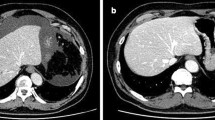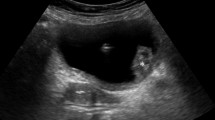Abstract
It is known that after transurethral resection of the prostate (TUR-P) or a bladder tumor (TUR-BT), necrotizing granuloma formation associated with massive eosinophil accumulation can be detected at the site of the scar, revealing marked eosinophilia. This condition is called post-TUR prostatitis or cystitis. In the present study, we noticed a similar phenomenon in five patients who underwent cholecystectomy, of whom four had gallbladder adenocarcinoma and one had metastatic liver cancer originating from the rectum. We detected necrotizing granulomas with massive eosinophil accumulation, associated with marked eosinophilia. To induce these phenomena, the interval between the first operation (i.e., cholecystectomy) and the second operation (i.e., resection of the hepatic bed and extrahepatic bile duct) is very important. If the interval was 1 week, no granuloma formation was detected. On the other hand, if it was more than 2 weeks, the resected hepatic bed contained necrotizing granulomas with substantial eosinophil accumulation combined with an increase in peripheral eosinophilia (up to 34% in one case). Secondary resection was necessary to induce eosinophilia after cholecystectomy. In this sense, malignancies possessed a relationship with delayed eosinophilia. In the granulomas, some foreign body-type multinucleated giant cells were positive for both anti-interleukin (IL)-5 and CD68 antibodies. In sharp contrast, no eosinophilia was detected after cholecystectomy, with or without hepatic resection consequent to severe adhesion. Clinicians as well as pathologists should keep in mind that these peculiar phenomena of eosinophil accumulation surrounding the necrotizing granulomas and peripheral eosinophilia after cholecystectomy could occur.
Similar content being viewed by others
References
Towfighi J, Sadeghee S, Wheeler JE, Enterline HT (1972) Granulomatous prostatitis with emphasis on the eosinophilic variety. Am J Clin Pathol 58:630–641
Hedelin H, Johansson S, Nilsson S (1981) Focal prostatic granulomas. A sequel to transurethral resection. Scand J Urol Nephrol 15:193–196
Epstein JI, Hutchins GM (1984) Granulomatous prostatitis: distinction among allergic, nonspecific, and posttransurethral resection lesions. Hum Patho 15:818–825
Helpap B, Vogel J (1986) TUR-prostatitis: histological and immunohistochemical observations on a special type of granulomatous prostatitis. Pathol Res Pract 181:301–307
Ohtsuki Y, Terao N, Kuwahara M, Ochi K, Iguchi M, Kurabayashi A, Matsumoto M, Takeuchi T, Furihata M (2007) Eosinophil infiltration in post-transurethral resection prostatitis and cystitis with special reference to sequential changes of eosinophilia. Med Mol Morphol 40:29–33
Ohtsuki Y, Fukumoto T, Okada Y, Teratani Y, Hayashi Y, Lee G-H, Furihata M (2010) Immunohistochemical and ultrastructural characterization of the signet-ring cell carcinoma component in a case of urothelial carcinoma of the urinary bladder. Med Mol Morphol 43:96–101
Dubucquoi S, Desreumaux P, Janin A, Klein O, Goldman M, Tavemier J, Capron A, Capron M (1994) Interleukin 5 synthesis by eosinophils: association with granules and immunoglobulin-dependent secretion. J Exp Med 179:703–708
Dubucquoi S, Janin A, Desreumaux P, Rigot JM, Copin MC, Francois M, Torpier G, Capron M, Gosselin B (1994) Evidence of eosinophil activation in eosinophilic cystitis. Eur Urol 25:254–258
Rosengart TK, Rotterdam H, Ranson JH (1990) Eosinophilic cholangitis: a self-limited cause of extrahepatic biliary obstruction. Am J Gastroenterol 85:582–585
Chen WH, Yu CC, Wu CC, Jan YJ (2009) Eosinophilic cholangitis with obstructive jaundice mimicking bile duct carcinoma. J Hepatobiliary Pancreat Surg 16:242–245
Miura F, Asano T, Amano H, Yoshida M, Toyota N, Wada K, Kato K, Takada T, Fukushima J, Kondo F, Takikawa H (2009) Resected case of eosinophilic cholangiopathy presenting with secondary sclerosing cholangitis. World J Gastroenterol 15:1394–1397
Horiuchi K, Kakizaki S, Kosone T, Ichikawa T, Sato K, Takagi H, Mori M, Sakurai S, Fukusato T (2009) Marked eosinophilia as the first manifestation of sclerosing cholangitis. Intern Med 48:1377–1382
Tajima K, Katagiri T (1996) Deposits of eosinophil granule proteins in eosinophilic cholecystitis and eosinophilic colitis associated with hypereosinophilic syndrome. Dig Dis Sci 41:282–288
Abraham SC, Leach S, Yeo CJ, Cameron JL, Murakata LA, Boitnott JK, Albores-Saavedra J, Hruban RH (2003) Eosinophilic pancreatitis and increased eosinophils in the pancreas. Am J Surg Pathol 27:334–342
Melo RCN, Weller PF (2010) Piecemeal degranulation in human eosinophils: a distinct secretion mechanism underlying inflammatory responses. Histol Histopathol 25:1341–1354
Author information
Authors and Affiliations
Corresponding author
Rights and permissions
About this article
Cite this article
Ohtsuki, Y., Kimura, M., Watanabe, R. et al. Marked infiltration of eosinophils in necrotizing granulomas in the resected hepatic bed after cholecystectomy resulting from gallbladder cancer and metastatic liver cancer is associated with peculiar peripheral eosinophilia. Med Mol Morphol 45, 53–57 (2012). https://doi.org/10.1007/s00795-011-0555-2
Received:
Accepted:
Published:
Issue Date:
DOI: https://doi.org/10.1007/s00795-011-0555-2




